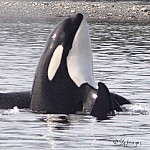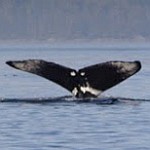Humans pose the biggest threat to marine mammals in the coastal waters of British Columbia. Decades ago, the commercial whaling industry hunted many species of whales to near extinction. In 1982, the International Whaling Commission instituted a worldwide moratorium on all commercial whaling from the 1985-1986 season on. According to a Marine Mammal Science article, at least 24,862 whales were taken from BC waters before that moratorium(1).
Marine mammals in BC include:
• Baleen whales (Gary, Humpback, Minke, Fin, Blue, Northern Pacific Right whale)
• Toothed whales (dolphins, porpoise, beaked, Sperm, Orca including Residents & Transients)
• Sea Otters, River Otters, and Pinnipeds (sea lions & seals)
Today, Blue, North Pacific Right and Southern Resident Killer whales are all listed as Endangered under the Species at Risk Act. Fin and Norther Resident Killer whales are considered Threatened while Grey and Humpback whales are listed as Special Concern as are Harbour Porpoise.
The most studied of marine mammals in coast waters of BC are the Southern Resident Orca of which there was estimated to be approximately 300 individuals before the 20th century. In 1975, 70 individuals remained after years of being captured for display, used as military target practices and shot at by fishermen. In 1985-1995, the population seemed to recover when its number reached closed to 100 individuals. However, as of September 2018, only 74 Southern Resident Orca remain. It is alarming that no surviving calves have been produced since 2015.
With projects like the Northern Gateway and Trans Mountain Expansion projects underway, an increase in tanker traffic through critical habitats of Cetaceans will result in an increase of stress of all marine mammals.
Today, Cetaceans face the following threats to their well-being:
A. Toxins and Pollution
1. Chemical pollution
2. Oil Spills
3. Toxic algae blooms
4. Plastic pollution
B. Underwater disturbance
1. Fishing industry (overfishing, by-catch, bottom-trawling)
2. Entanglements
3. Boat strikes
4. Noise pollution
5. Hunting and capture
The threats against marine mammals are complicated and numerous. It can be overwhelming to learn about all these threats. But you can help mitigate these threats by reading through the “What Can You Do?” Sections, picking a few suggestions and acting on them from there. You can make a difference and ensure Cetaceans remain an important part of the ecology in British Columbia.
(1) Gregr, E.J., Nichol, L. Ford, J.K.B., Ellis, G., and Trites, A.W. (2000) Migration and population structure of northeastern Pacific whales off coastal British Columbia: an analysis of commercial whaling records from 1908-1967, Marine Mammal Science 16 (4)


